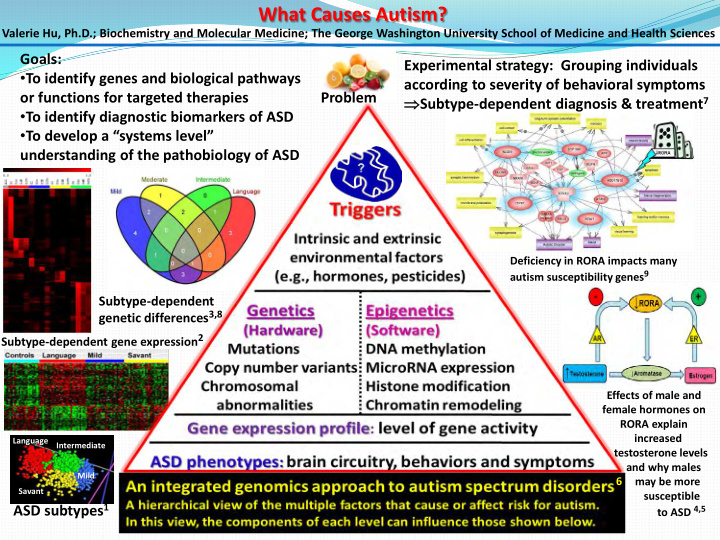



What Causes Autism? Valerie Hu, Ph.D.; Biochemistry and Molecular Medicine; The George Washington University School of Medicine and Health Sciences Goals: Experimental strategy: Grouping individuals • To identify genes and biological pathways according to severity of behavioral symptoms or functions for targeted therapies Problem ⇒ Subtype-dependent diagnosis & treatment 7 • To identify diagnostic biomarkers of ASD • To develop a “systems level” understanding of the pathobiology of ASD Deficiency in RORA impacts many autism susceptibility genes 9 Subtype-dependent genetic differences 3,8 Subtype-dependent gene expression 2 Effects of male and female hormones on RORA explain increased Language Intermediate testosterone levels and why males Mild 6 may be more Savant susceptible ASD subtypes 1 to ASD 4,5
Publications Research articles Reviews/perspective/ editorial/commentary Autism Research Future Neurology Molecular Autism Child Development FASEB Journal Pharmacogenomics Genome Medicine Disease Markers PLoS ONE NeuroToxicology BMC Genomics MicroRNAs in Toxicology North American J. of and Medicine (book Medicine and chapter) Science
Selected References 1) Hu, V.W. and Steinberg, M.E. (2009) Novel clustering of items from the Autism Diagnostic Interview- Revised to define phenotypes within autism spectrum disorders. Autism Research 2:67-77. 2) Hu, V.W., Sarachana, T., Kim, K.S., Nguyen, A., Kulkarni, S., Steinberg, M.E., Luu, T., Lai, Y., and Lee, N.H. (2009) Gene expression profiling differentiates autism case-controls and phenotypic variants of autism spectrum disorders: Evidence for circadian rhythm dysfunction in severe autism. Autism Research 2:78-97. 3) Hu, V.W., Addington, A., and Hyman, A. (2011) Novel Autism Subtype-dependent Genetic Variants are Revealed by Quantitative Trait and Subphenotype Association Analyses of Published GWAS Data. PLoS ONE 6(4):e19067. 4) Nguyen, A., Rauch, T.A., Pfeifer, G.P., and Hu, V.W. (2010) Global methylation profiling of lymphoblastoid cell lines reveals epigenetic contributions to autism spectrum disorders and a novel autism candidate gene, RORA, whose protein product is reduced in autistic brain. FASEB J., 24(8):3036-51. 5) Sarachana, T., Xu, M., Wu, R.-C., and Hu, V.W. (2011) Sex hormones in autism: Androgens and estrogens differentially and reciprocally regulate RORA, a novel candidate gene for autism. PLoS ONE, 6(2): e17116. 6) Hu, V.W. (2012) From Genes to Environment: Using integrative genomics to build a “systems level” understanding of autism. Invited review, Child Development, 84(1):89-103. 7) Hu, V.W. (2012) Subphenotype-dependent disease markers for diagnosis and personalized treatment of autism spectrum disorders. Invited review, Disease Markers, 33(5):277-88. 8) Talebizadeh, Z., Arking, D.E., and Hu, V.W. (2013) A novel stratification method in linkage studies to address inter and intra family heterogeneity in autism. PLoS ONE, 8(6):e67569. 9) Sarachana, T. and Hu, V.W. (2013) Genome-wide identification of transcriptional targets of RORA reveals direct regulation of multiple genes associated with autism spectrum disorder. Molecular Autism, 4:14. More at: http://www.gwumc.edu/smhs/facultydirectory/profile.cfm?empName=Valerie%20Hu&FacID=2046028605
Recommend
More recommend